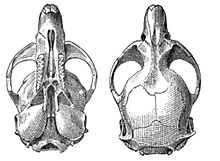Creeping vole
The creeping vole (Microtus oregoni), sometimes known as the Oregon meadow mouse, is a small rodent in the family Cricetidae.
Ranging across the Pacific Northwest of North America, it is found in forests, grasslands, woodlands, and chaparral environments.
The small-tailed, furry, brownish-gray mammal was first described in the scientific literature in 1839, from a specimen collected near the mouth of the Columbia River.
[4] The type specimen was an older male collected November 2, 1836 near the mouth of the Columbia River in Oregon.
[5] The skull of the creeping vole has a low, flat profile, with a long and slender snout.
[5] Creeping voles are found in British Columbia in Canada and in Washington, Oregon and northern California, in the United States.
[1] They are found as far north as Port Moody, British Columbia and as far south as Mendocino City, California.
[5] The western range in Washington extends east to Mount Aix, Lake Chelan, and Signal Peak.
[5] Creeping voles establish nests of dry grass in protected areas, such as under logs.
A models for the evolution of creeping vole sex chromosomes was published by researchers from the University of Edinburgh in 2001.
[1] The justifications for the listing are the lack of major threats, the stability of populations, and the adaptability of the animal to environmental changes.
[1] Treatment of Douglas-fir plantations with herbicides in British Columbia did not affect creeping vole populations.
[1] No conservation concerns are raised, since there are thought to be sufficient areas of protected habitat within its range.

